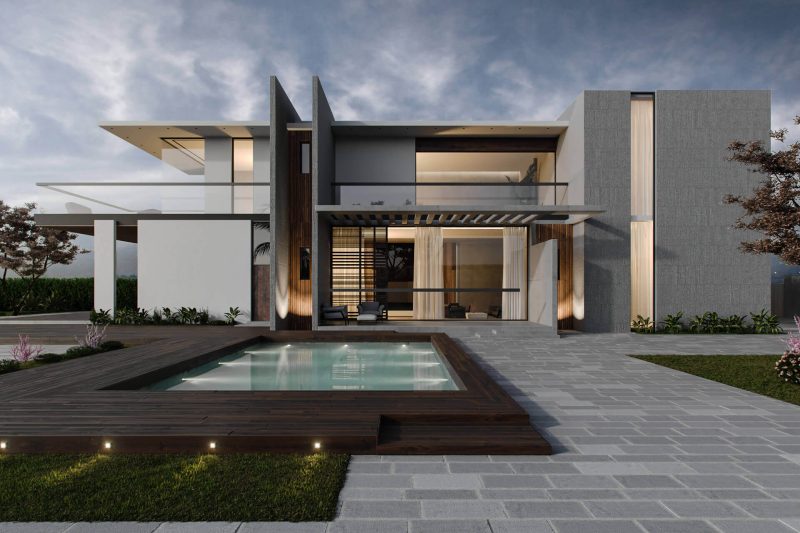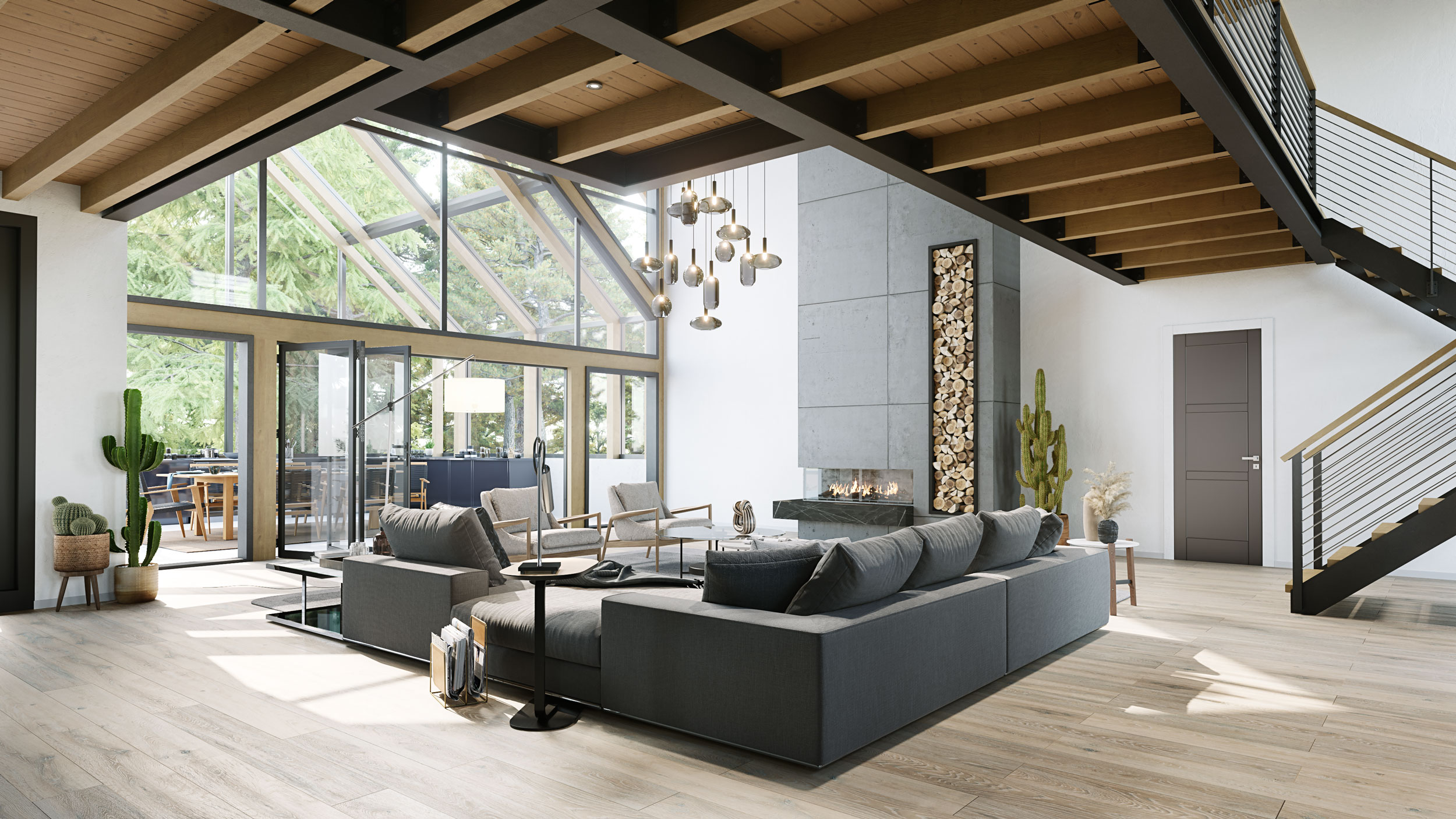Corona Renderer for 3ds Max is a rising star among rendering plugins. Version 1.0 saw the light only in 2015, and the software has gained an incredible popularity since then. With its user-friendly interface, a shallow learning curve and immense creative possibilities, Corona is a great option for 3D visualization studio working pipeline. It has a number of features allowing to attain a striking realism, set any atmosphere the author chooses and create amazing lighting and materials. So 3D Artists use the plugin for exterior and 3D interior design services as well as product visualizations that make then strong presentation materials and stellar marketing visuals for creative advertising and branding.
What are those brand-new features that make Corona Renderer for 3ds Max stand out? Let’s learn about 5 crucial ones.
#1. Corona Renderer Produces Physically Correct Images
The most striking thing about Corona renderer for 3ds Max is that it combines the benefits of both biased and unbiased approaches to 3D graphics. How’s that? Let’s see.
Unbiased rendering relies on a precise approximation of real light’s behavior. Theoretically, it could produce more realistic images. Nevertheless, it’s a mathematical model, a shortcut itself. In practice, unbiased renderers for 3ds Max produce images comparable to those from biased ones. They need fewer settings from the user, but computations they do last extremely long.
Biased renderers use shortcuts such as cutting the number of light bounces, reducing the intensity of light on each bounce, interpolating illumination, disabling caustics. Although developers often hardcode such tricks into the renderer, those affecting realism or artistic effect are available for customization. As a result, a 3ds Max specialist has to tweak the scene and optimize the settings a lot to get a quality image, but computations go fast.
By default, a Corona render is only slightly biased. The developers introduced those biases and to that extent that they don’t hamper realism. Like unbiased renderers, the software delivers quality results with few or no tweaks by the artist. Like fully biased one, it works fast. According to the developers, the default settings fit 95% of visualizations. Practice shows that they work best for 90% of 3D scenes.
The same benefit applies to using Corona for 3D architectural animation services. Creating a video would be too challenging for an unbiased renderer, but Corona easily takes it on. And the result is free from flickering, a common issue when biased renderers are used.
#2. Corona Renderer Allows for a Smoother Workflow
Besides modeling and texturing, a 3ds Max specialist has a lot of things to do for the render to have a desired effect on the audience:
- choose the most advantageous angle for the product, interior, or exterior 3D rendering services
- set the parameters that ensure both high quality and acceptable speed
- customize materials, lights, and the camera for the same purpose
- do post-production tricks for a more atmospheric and quality image
If anything goes wrong, the artist has to find a fix and start rendering again. Luckily, Corona render engine gives a CGI professional several options that allow to keep everything under thumb.
1) Powerful and Easy-to-Use Interactive Rendering
There are other applications that feature interactive rendering, but in Corona Renderer for 3ds Max, it stands out in terms of usability and functionality. It calculates the scene fast enough to see the result of the changes within a couple of seconds.
Moreover, there are lots of things a 3ds Max specialist can modify interactively: camera position and settings, position, orientation, and visibility of objects, properties of lights and Corona Renderer materials.To save time, a 3D artist is free to reduce the scope of calculations by limiting interactive rendering to a particular region – an option also available on the go.
2) An Opportunity to Balance Speed and Quality
It happens that fast delivery is crucial, while quality has just to be acceptable. Another situation: a certain level of fineness is a must, and there’s an abundance of time for it. A third one: both allow for flexibility, but the priority is a particular balance between them.
Corona Renderer for 3ds max allows for any of these scenarios: a 3D artist can limit rendering by time, by noize level, or by the number of iterations. Another option for even more control is to run progressive rendering without setting limits and stop it manually.
3) Effective Denoiser to Cut Post-Production Work
Though a handful of other rendering engines are also bundled with a denoiser, their users prefer to wipe noise in Photoshop. With Corona Renderer for 3ds Max, there’s no need to do so: the built-in tool is fully operable.
Corona allows to set the intensity of the filter before or during the rendering and see the result immediately. The visualization completed, the 3ds Max specialist can reduce the effect if some important details are missing. Or, to the contrary, increase it if the Corona render looks better this way. This way, the artist needs only to run Photoshop for the task it performs best, namely 3D visualization post-production tricks.
#3. Corona Renderer Delivers Highly Predictable Results
Distributed rendering is a complicated process. There are plenty of settings on each computer, lots of things likely to go wrong – a computer doesn’t connect, a file is unavailable. As a result, the render splits into tiles, on some of which a texture is missing or light is incorrect, or noise irreparably corrodes the image. In Corona, distributed rendering is available in a few clicks. A remote machine either connects if it is free or not if it is busy. The renders are good anyway.
Another risk Corona render engine successfully mitigates is importation bugs. A 3ds Max specialist uses third-party tools for objects such as forests and lakes, flame and hair. Moreover, there are a lot of ready-to-use models and materials created in other software. Corona carefully imports scenes and objects created in dozens of other 3ds Max plugins. Thus, a 3D artist is free to go on using his or her favorite tools and to produce quality visualizations.
#4. Corona Renderer Provides Advanced Light Options
The standard approach to light is the following: a 3ds Max specialist customizes all of its sources to see the result only in the render. Introducing changes into lighting means changing the settings and running the renderer again. To eliminate this excessive work, Corona Renderer features Interactive Light Mix. The tool allows a 3D artist to set color and intensity during or after rendering, no matter whether standard or interactive.
Equally important for a realistic image are the loom and glare effects – and twice as important when it comes to a Corona HDRI render. Both bloom and glare are glowings coming from a very bright light source or shiny surface. The difference is that bloom is soft and homogeneous whereas glare falls into strands or feathers. Although these effects are available in a 2D graphics editor like Photoshop, it’s much easier to use them in 3D software. Corona Renderer for 3ds Max provides such an opportunity. As a result, it’s very easy to depict glowing windows in an interior visualization or shiny surfaces in a product render. Or recreate the bright sunshine glaring from between branches and leaves of a tree in exterior imagery.
#5. Corona Features Powerful Procedure Maps
Textures aren’t always regular: two parquet boards are never identical, and two roof tiles slightly differ by color and spatial orientation. As for leaves in exterior renderings, they also vary by tint. Adding diversity by hands would be exceedingly weary and long-lasting.
Luckily, Corona has procedure maps that address unnecessary regularities. For instance, UVW Randomizer adds irregularity to scale, offset, or rotation of Corona render materials and textures. Corona MultiMap is another randomization tool that allows to assign different textures and maps to different objects or even their polygons.
Corona Renderer for 3ds Max is second to none when it comes to landscapes. Let’s consider, for example, a visualization of a house exterior on a seaside cliff. Using a Corona triplanar map will be the easiest way to texture the landscape: a single material will be enough for both the ground surface and the exposed rock. After that, it’s time for Corona Scatter: the tool will randomly plant various grasses, shrubs, trees across a dedicated area.

Corona Renderer for 3ds Max helps create photoreal pictures and animations that mesmerize the viewer – with less effort and nevertheless more control. It means that striking presentations, quality product pictures, plenty of visuals for promotion are available even faster.
At ArchiCGI, our 3D artists use Corona Renderer for 3ds max too – along with V-Ray, which has some advantages – and achieve equally striking results.
Showcase your architectural project like a true work of art, brought to life with cutting-edge AI-powered CGI technology.
Need high-quality 3D Renderings for your project? Contact us for CGI services. We will create photorealistic imagery that will sell your ideas better than a 1000 words.

Irma Prus
Content Writer, Copywriter
Irma writes articles and marketing copy for ArchiCGI. Her dream is that more people discover the power of CGI for architecture. Irma is into neuromarketing, ruby chocolate and Doctor Who series.



